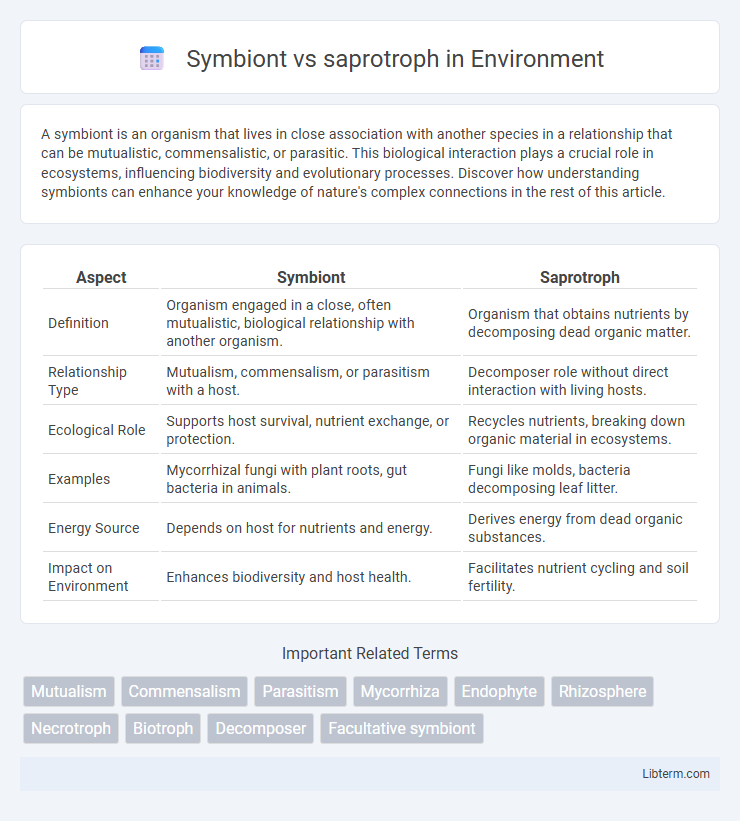A symbiont is an organism that lives in close association with another species in a relationship that can be mutualistic, commensalistic, or parasitic. This biological interaction plays a crucial role in ecosystems, influencing biodiversity and evolutionary processes. Discover how understanding symbionts can enhance your knowledge of nature's complex connections in the rest of this article.
Table of Comparison
| Aspect | Symbiont | Saprotroph |
|---|---|---|
| Definition | Organism engaged in a close, often mutualistic, biological relationship with another organism. | Organism that obtains nutrients by decomposing dead organic matter. |
| Relationship Type | Mutualism, commensalism, or parasitism with a host. | Decomposer role without direct interaction with living hosts. |
| Ecological Role | Supports host survival, nutrient exchange, or protection. | Recycles nutrients, breaking down organic material in ecosystems. |
| Examples | Mycorrhizal fungi with plant roots, gut bacteria in animals. | Fungi like molds, bacteria decomposing leaf litter. |
| Energy Source | Depends on host for nutrients and energy. | Derives energy from dead organic substances. |
| Impact on Environment | Enhances biodiversity and host health. | Facilitates nutrient cycling and soil fertility. |
Introduction to Symbionts and Saprotrophs
Symbionts engage in mutually beneficial relationships with other organisms, often exchanging nutrients or protection to enhance survival for both parties involved. Saprotrophs obtain nutrients by decomposing dead organic matter, playing a critical role in nutrient cycling and ecosystem health. Understanding the functional differences between symbionts, such as lichens or mycorrhizal fungi, and saprotrophs like fungi or bacteria, highlights their distinct ecological roles.
Defining Symbionts: Key Characteristics
Symbionts engage in close, often long-term interactions with other organisms, ranging from mutualism to parasitism, where both entities typically benefit or one gains advantage without outright harm. They exhibit specialized adaptations that facilitate nutrient exchange, protection, or other mutual benefits, often influencing the physiology or behavior of their hosts. Unlike saprotrophs, which obtain nutrients by decomposing dead organic matter, symbionts rely on living hosts for survival and ecological function.
Saprotrophs Explained: Roles and Functions
Saprotrophs play a crucial role in ecosystems by decomposing dead organic matter and recycling nutrients back into the soil, which supports plant growth and sustains the food web. Unlike symbionts that engage in mutualistic or parasitic relationships with living organisms, saprotrophs obtain energy through the extracellular digestion of dead material using enzymes. This decomposition process carried out by fungi, bacteria, and some protists is essential for carbon cycling and maintaining soil fertility.
Symbiotic Relationships in Nature
Symbionts form mutually beneficial relationships with other organisms, enhancing survival and resource acquisition for both partners, such as mycorrhizal fungi exchanging nutrients with plant roots. Saprotrophs, in contrast, decompose dead organic matter, recycling nutrients back into ecosystems without direct interaction with living hosts. Symbiotic relationships involving symbionts are critical in maintaining ecosystem stability and biodiversity by facilitating nutrient cycling, host protection, and energy flow.
Saprotrophic Mechanisms of Nutrient Acquisition
Saprotrophs acquire nutrients through extracellular digestion by secreting enzymes that break down complex organic matter into simpler molecules, which are then absorbed. This nutrient acquisition mechanism contrasts with symbionts, which often obtain nutrients through direct exchange with their host organisms. Saprotrophic decomposition plays a crucial role in nutrient cycling and ecosystem functioning by recycling dead organic material into bioavailable nutrients.
Ecological Importance of Symbionts
Symbionts play a crucial role in ecosystems by forming mutualistic relationships that enhance nutrient cycling, plant growth, and soil fertility, often improving ecosystem resilience. Unlike saprotrophs, which primarily decompose dead organic matter, symbionts actively support host organisms such as plants and animals through nutrient exchange and protection against pathogens. This mutualistic interaction increases biodiversity and stabilizes ecological communities, making symbionts fundamental to ecosystem health and productivity.
Ecological Significance of Saprotrophs
Saprotrophs play a crucial ecological role by decomposing dead organic matter, recycling nutrients back into ecosystems, and maintaining soil fertility. Unlike symbionts that engage in mutually beneficial relationships with host organisms, saprotrophs exclusively obtain nutrients through breaking down complex organic compounds, ensuring carbon and nitrogen cycles continue uninterrupted. Their activity supports plant growth and ecosystem productivity by transforming waste into bioavailable substances.
Key Differences: Symbiont vs Saprotroph
Symbionts engage in mutually beneficial relationships with their hosts, relying on direct interaction to exchange nutrients or services, whereas saprotrophs obtain nutrients by decomposing dead organic matter independently. Symbiotic associations are often highly specific and involve living organisms, while saprotrophic nutrition primarily occurs through extracellular digestion and absorption in non-living substrates. The ecological roles differ as symbionts contribute to biodiversity and host survival, whereas saprotrophs are essential decomposers maintaining nutrient cycling in ecosystems.
Examples of Symbionts and Saprotrophs
Examples of symbionts include nitrogen-fixing bacteria such as Rhizobium in legume roots and mycorrhizal fungi that enhance nutrient absorption for plants. Saprotrophs include fungi like Aspergillus and bacteria such as Bacillus species, which decompose dead organic matter, recycling nutrients in ecosystems. Symbionts engage in mutually beneficial relationships, while saprotrophs obtain nutrients from decaying material without benefiting the host.
Conclusion: Interactions and Environmental Impact
Symbionts form mutually beneficial relationships that enhance nutrient exchange and ecosystem stability, while saprotrophs play a crucial role in decomposing organic matter, recycling nutrients back into the environment. The interaction of symbionts with host organisms supports biodiversity and ecosystem productivity, whereas saprotrophs contribute significantly to soil health and carbon cycling. Both interactions are essential for maintaining ecological balance and sustaining environmental resilience.
Symbiont Infographic

 libterm.com
libterm.com